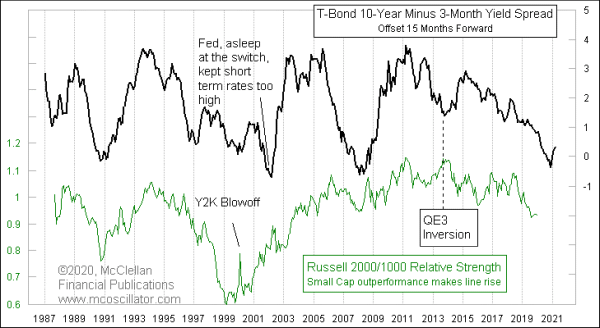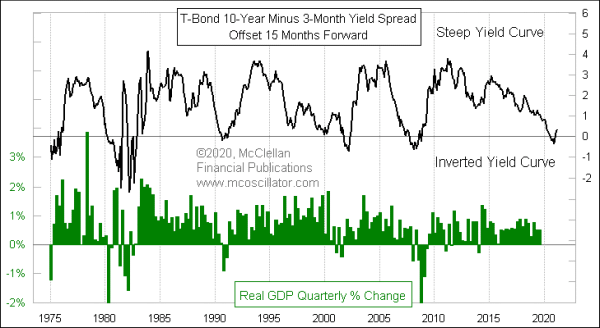
Small cap stocks have been underperforming large ones since mid-2018, and this underperformance should continue until the end of 2020.
This week’s chart shows a relative strength line (green) for the Russell 2000 Index versus the Russell 1000. It is a very simple calculation, dividing the R2’s index value by the R1’s. When the line is rising, that means small caps are outperforming on a relative basis. That outperformance can mean going up faster, or going down more slowly. If you are an investor in small cap related stocks or ETFs, you want this line to be rising.
Also included in this chart is a measure of the yield spread between 10-year and 3-month Treasuries (black line). That plot is shifted forward by 15 months to help us see how its movements tend to get repeated in the R2/R1 relative strength line. It does not always repeat perfectly, especially when the Fed puts a thumb on the scale. But generally speaking, the relative strength line echoes the dance steps of the yield curve.
That is important because on a monthly closing basis, that yield spread bottomed in August 2019. Counting 15 months forward, we get November 2020 for when the relative strength line should ideally find its own bottom. That means around 10 more months of small cap underperformance from here.
This 15-month lag is also important in other ways. Here is that same spread between 10-year and 3-month yields, compared to the quarterly change in GDP, once again using a 15-month forward offset:

Everyone already knows that an inverted yield curve is a warning sign of an economic recession. But what is really interesting is that if we run a Pearson’s Correlation Coefficient for these two plots in real time, they only have a +0.05 correlation factor. In other words, no correlation at all, according to that statistic.
But if we adjust that calculation for the 15-month lag, then the correlation jumps up to +0.29. That’s far from a perfect correlation, and the somewhat low correlation score comes about because sometimes the magnitudes of the two plots’ movements are not equal. But what we care about is the direction of movement, and when GDP growth turns negative. On that basis, the periods of inversion have a really good track record.
Perhaps the most interesting point about this 15-month offset is that the timing of the August 2019 bottom for this yield spread means that November 2020 is when small cap relative strength and economic growth should be bottoming out. And that is when the U.S. will hold its next presidential and congressional elections. So watch for the topics getting debated among the candidates to start shifting to economic growth themes.
Tom McClellan
Editor, The McClellan Market Report